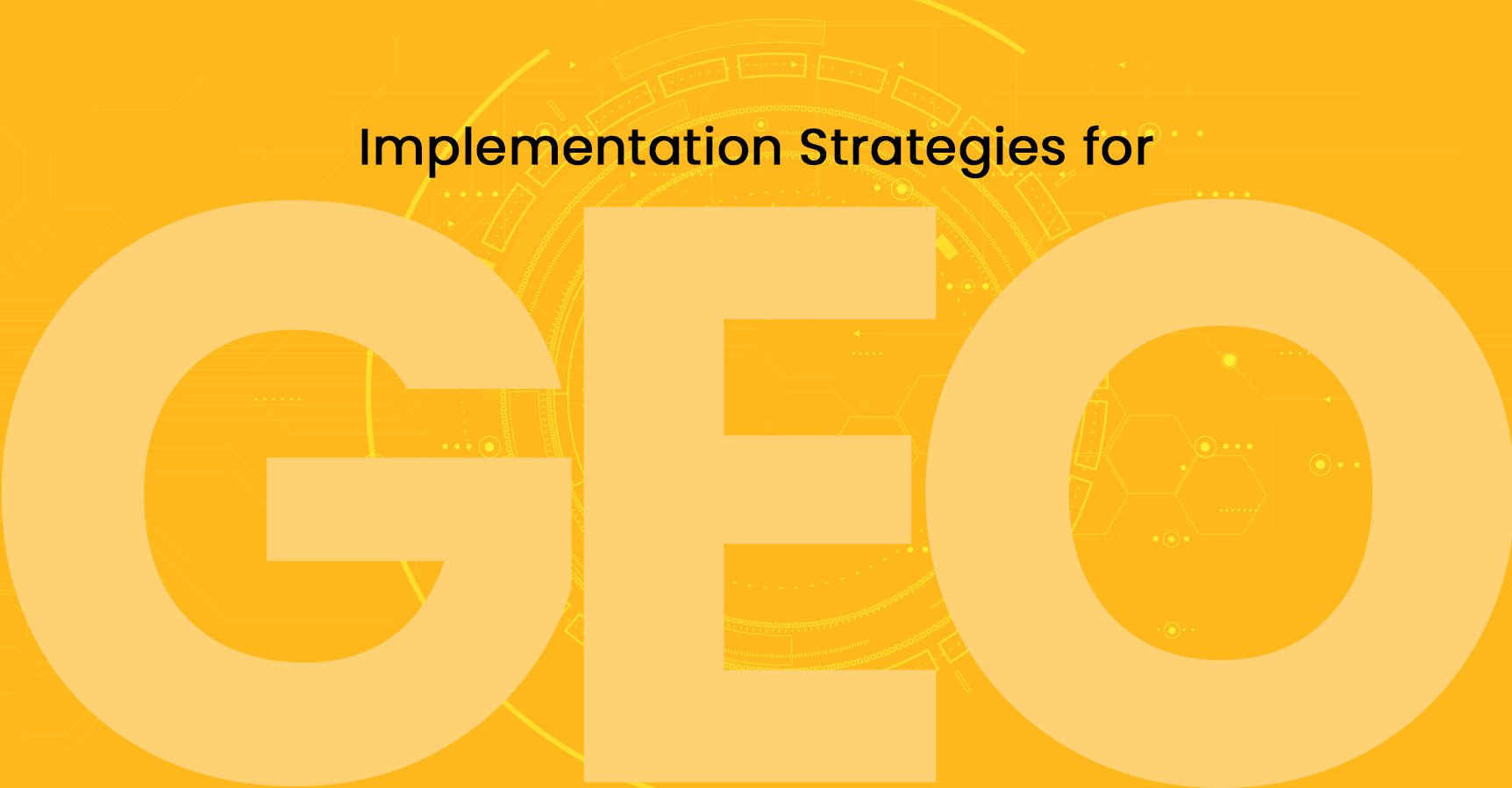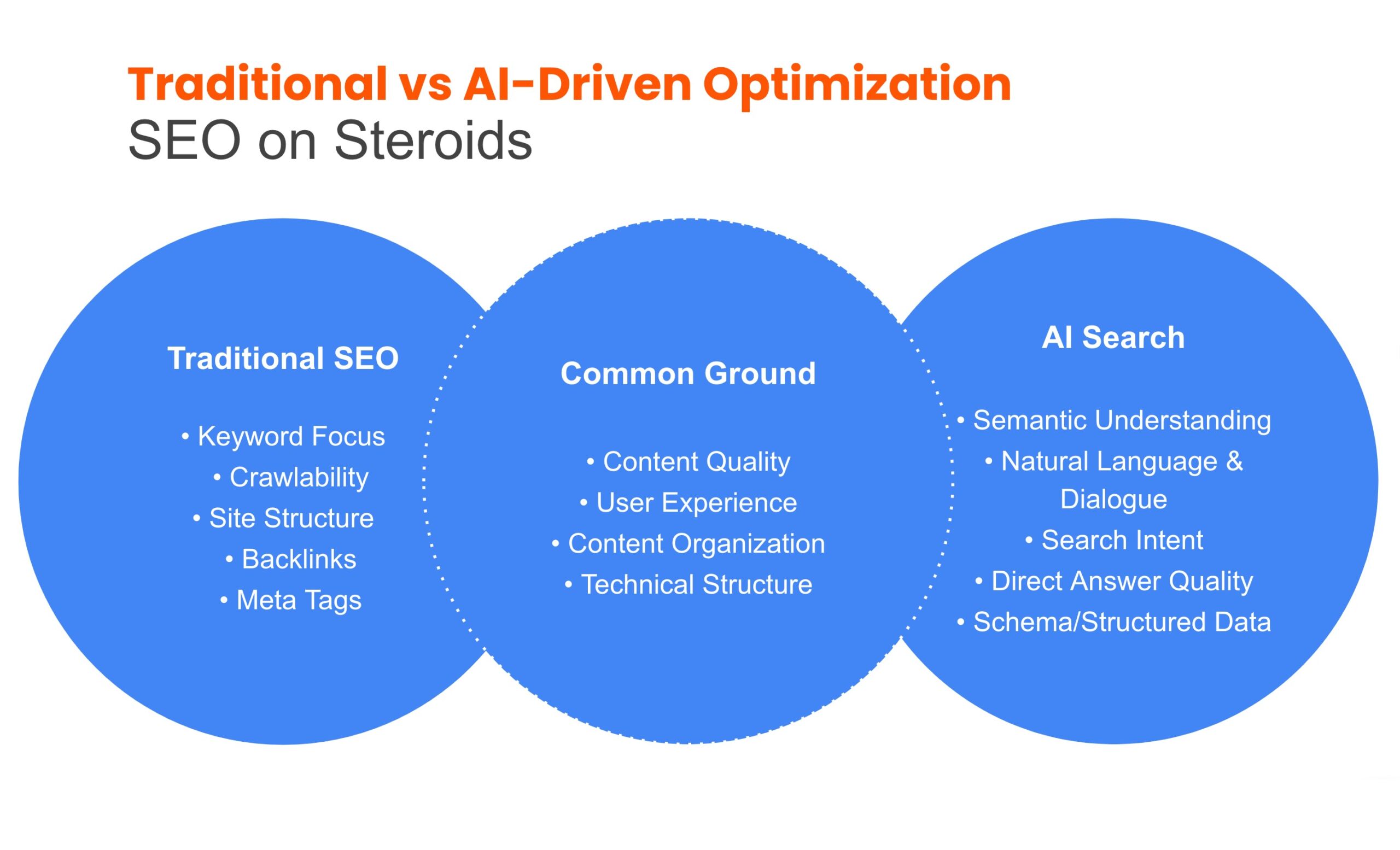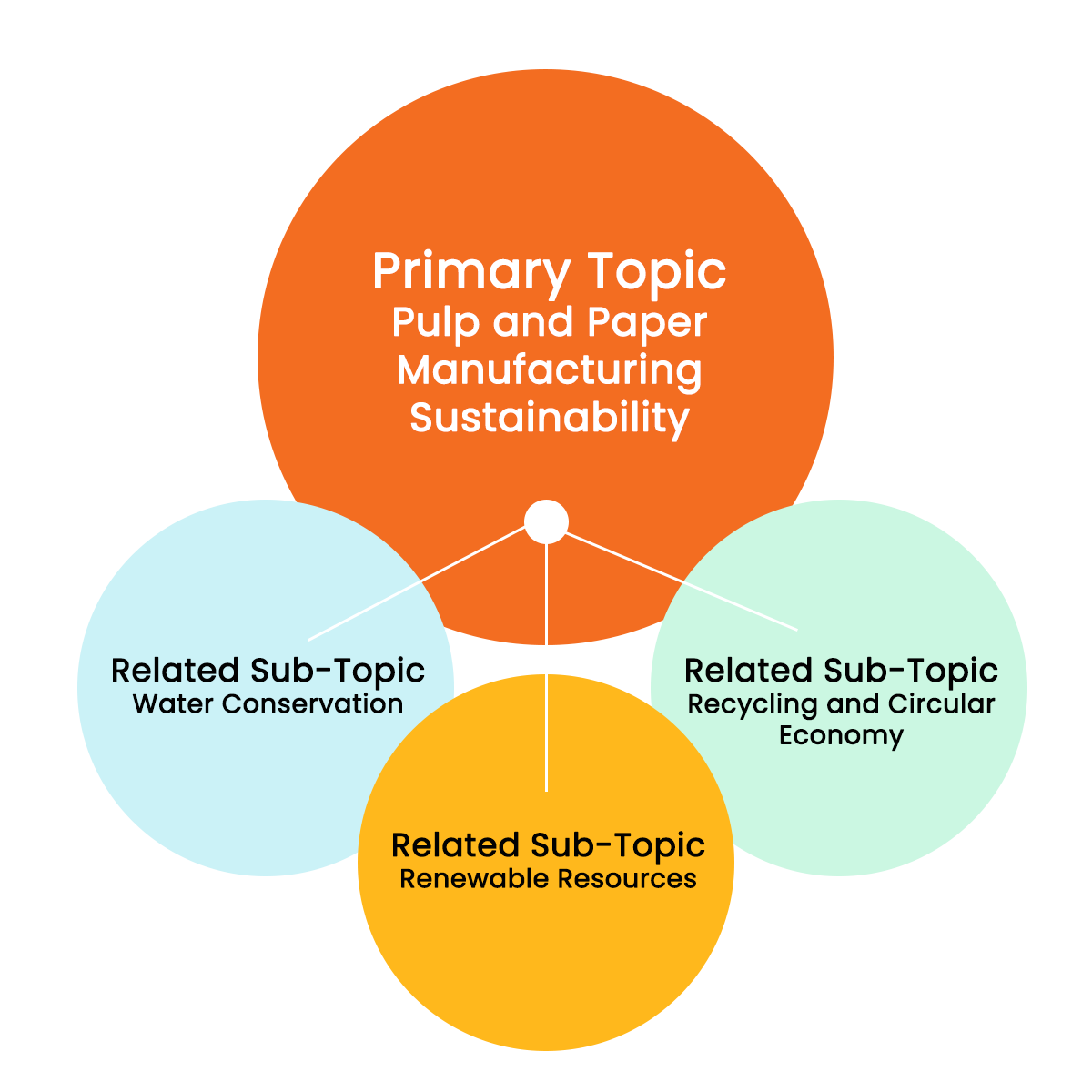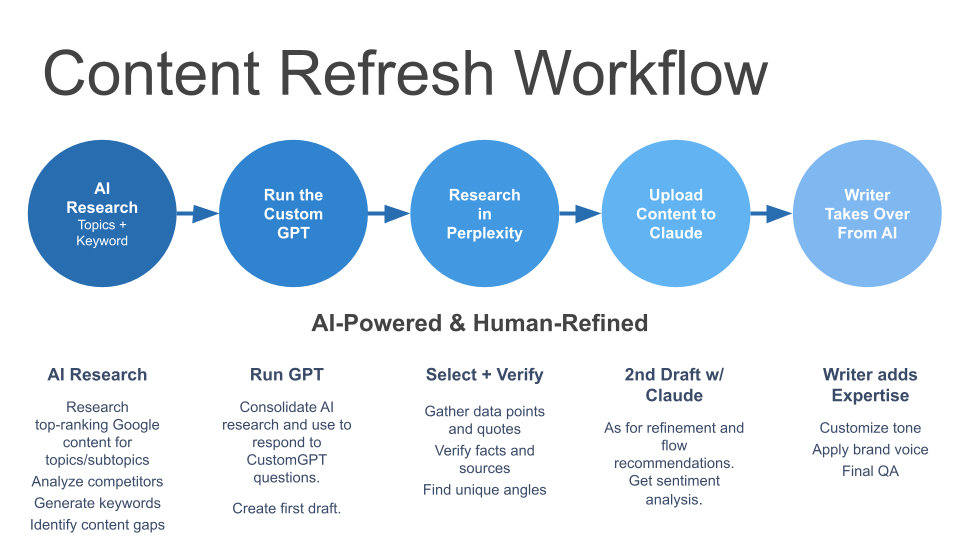Beyond SEO: Your GEO Checklist for AI Search Engines

AI now decides what gets seen online.
AI systems now influence which content shows up in answers. They scan your writing, pull out key details, and decide whether it fully answers a user’s question.
The clearer, more structured, and more context-rich your content, the better your chances.
SEO doesn’t go far enough.
Traditional SEO wasn’t designed for how platforms like Gemini and ChatGPT pull answers, summarize content, and cite sources.
To stay visible in AI answers, focus on clarity and structure.
Focus on structure and clarity: use descriptive headings, embed FAQs and schema markup, and cite trustworthy sources. These steps help generative engines understand and surface your content.
GEO Checklist for AI Search Success
This guide gives you practical steps to help your content appear in generative engines like ChatGPT, Gemini, and Perplexity.
Why does this matter?
When AI systems clearly understand your content, they’re more likely to share it accurately—and more often. These guidelines show you how to optimize for AI comprehension while keeping human readers engaged. Want to know how people actually read online? Learn more here.
SEO helped us reach human readers through Google. But AI platforms require a new approach—enter GEO: Generative Engine Optimization.
What is GEO?
Generative Engine Optimization (GEO) is the practice of shaping your content so AI systems can easily understand and distribute it. While traditional SEO focuses on search algorithms, GEO focuses on how AI processes and selects information.
GEO emphasizes semantic clarity, contextual depth, and AI-friendly language. The goal: make it easy for AI platforms to accurately interpret and share your content.
Here’s how traditional SEO and AI search optimization work together, sharing core principles while each playing a critical role in modern content discovery
- SEO is about being found by algorithms
- GEO is about being found AND understood by AI.
Your Action Plan for GEO Success
PLAN IT
Make Your Content AI-Ready from the Start
- Write in a modular, answer-focused sections
Break your content into short, focused sections—each answering a single question in 150–300 words. AI engines pull answers in chunks, so make sure each section delivers value on its own. - Use structure AI can easily scan
AI systems prioritize content with clear structure. Use descriptive headings, short paragraphs, and question-based subheads. Add a short FAQ section on the page (see the FAQ section below for an example). This gives AI engines clear, question-and-answer pairs to pull from when generating summaries and answers. - Group related topics to build authority
Organize your content into topic clusters. Link related pages to reinforce your expertise and help AI engines understand how your content pieces fit together. (see graphic below) - Anticipate Follow-Up Questions
AI search often happens in stages, with users asking follow-up questions in the same session. Structure your content to answer the initial query—and then go deeper. Address likely next questions or related topics. This increases your chances of appearing across multiple steps in the user’s search journey. - Name people, products, and places clearly
Mention your brand, products, people, and partners by name. This helps AI systems connect your content with recognized entities.
CREATE IT
- Write plain-text facts that AI can cite
State key stats, outcomes, and claims in clear, straightforward language. Example: “Company X cut fraud by 35% in 12 months.” Avoid burying facts in marketing language—AI struggles to extract facts hidden inside promotional copy. - Use clear H2 and H3 headers that map to real questions
Format your subheadings as questions people actually ask. This helps generative engines recognize and reuse your content when answering similar user queries. - Add descriptive alt text—but only for images with data or key insights
Focus on images that show facts, processes, or results. For example, instead of saying “dashboard screenshot,” describe what the dashboard shows: “Graph showing 35% fraud reduction over 12 months.”
STRUCTURE IT
Give AI Clear Signals About Your Content
- Use structured data and schema markup.
Add FAQ, HowTo, or Product schema where it makes sense. Structured data helps AI engines understand your content’s format and key sections—making it easier for them to extract and surface your information in answers. - Highlight trusted authors with real credentials
Include author bios that show expertise—such as credentials, awards, or industry recognition. AI systems prefer content tied to credible, verifiable sources. The stronger your author signals, the better your chances of being cited
TEST IT
See If Your Content Shows Up in AI Answers
- Run real-world AI searches
Test your content in tools like ChatGPT, Gemini, Perplexity, and Claude. You can also license ChatHub to see all platforms at once. Ask the kinds of questions your audience would. See if your brand gets mentioned—or if your content is cited in the answer. - Check your visibility in AI engines
Use tools like ChatHub to run searches like: “Top [your product] platforms.” Does your brand appear? If not, it’s a sign your content may need stronger signals for AI discovery. - Track branded question queries over time
Set up recurring searches or alerts for key branded questions. Monitor where your brand appears in AI answers—and adjust your content based on what’s being cited (or what’s missing). - Strengthen trust by citing credible sources
Link to respected third-party data and publications. AI engines favor content that pulls from trusted references—and they’re more likely to cite your page in return. - Keep your key pages fresh
Update your top-performing pages every 90 days. Refresh stats, examples, and facts to stay current and give AI platforms a reason to keep surfacing your content.
AI search success requires more than structure and metadata.
How you write—and the language you choose—also shapes how generative engines interpret, summarize, and select your content. This is where tone, clarity, and brand voice play a critical role.
Speak AI
Your New Marketing Dictionary→
- GEO
Optimizing your content so AI systems can understand and distribute it effectively. - Generative AI
AI tools that create new content—like text, images, code, or audio—based on patterns from their training data. - LLM (Large Language Model)
AI systems like ChatGPT and Claude that process and understand human language. - Semantic Search
A context-aware search approach where AI focuses on understanding user intent—not just keywords. - Content Architecture
How you organize and structure information across your site to help both humans and AI find and understand it.
Free Tools You’ll Need for GEO Implementation
🔧 GEO Automated Content Optimizer GPT: Take any URL and get an AI-optimized version of your content. Perfect for refreshing existing content—paste your current page URL, answer a few questions, and the AI will return a polished, AI-friendly “first draft” tailored for search engines and LLMs.
🔧 FAQ Schema Generator: Convert your FAQ content into AI-friendly structured data. Paste your Q&As and generate ready-to-use schema markup that helps LLMs better understand your content. No technical knowledge required!
The Proof
After applying GEO best practices, this FBO Accounts article quickly reached Google’s top 3 organic results for ‘FBO accounts.’ It also appears in Google’s AI Overviews—proof that AI-optimized content drives both search ranking and AI answer visibility.
Upskill Your Content Team
Don’t let your team fall behind in GEO capabilities. Learn more about our custom, expert-led GEO services and equip your organization to master content optimization for the new era of generative search engines.
The Complete Guide to LLM Content Optimization
Start with the essentials—these steps help AI engines identify, summarize, and cite your content accurately.
Content Creation Fundamentals
1. Write Unique, Meaningful Page Titles
A page title, defined by the HTML <title> tag, is the text displayed on search engine results pages and browser tabs.
Why it matters: It tells both users and AI-driven platforms what your page is about.
Best Practice: Make every page title unique and focused. Summarize your content’s value clearly—without repeating exact phrases from the body text. Use our free tool to visualize your meta data.
2. Create In-Depth, Comprehensive Content
Your content needs to answer real questions with clear facts, insights, and explanations. The more direct and plain your language, the better your chances of appearing in AI-generated answers.
Go beyond what’s already out there. Unique insights or data that users can’t easily find elsewhere make your content stand out—and more likely to get picked up in AI summaries. AI search now favors pages that help people accomplish tasks, compare options, or quickly understand a topic.
Aim for full-topic coverage—typically 1,500 words or more.
What to include:
- Tight, focused paragraphs
- Multiple perspectives and angles on the topic
- Real-world case studies or practical examples
- Clear definitions of technical terms upfront for readability
Example: Instead of a brief overview like “What is cloud computing?”—build out full sections covering service types, implementation strategies, costs, and security considerations. Wherever possible, use real examples from known industry players like AWS, Azure, or Google Cloud.
3. Use Clear, Natural Language That AI and People Understand
Use natural, human language—the way you would speak. Skip corporate jargon and marketing buzzwords.
Stick to short, clear sentences with strong, active verbs. Say “buy” instead of “make a purchase,” or “use” instead of “utilize.” AI engines process direct, plain language better than bloated copy.
Start with a short summary to give both readers and AI immediate context. When it fits your brand voice, contractions and casual language can make your content sound more approachable.
One final test: read your content aloud. If it sounds stiff or overly formal, rewrite it until it flows like real conversation.
4. Structure Content for Clarity
Help readers (and AI) scan your content quickly. Use descriptive subheadings that clearly signal what each section covers.
Break up dense text with short paragraphs and plenty of white space—the eye is naturally drawn to text that stands apart from clutter.
Add captions that explain what the image shows—especially if it illustrates a key point or data. Keep your formatting consistent across the page so both humans and AI can easily follow your structure.
5. Focus on Topic Relevance—Not Keywords
AI systems don’t rely on exact-match keywords like traditional search engines. Instead, they look for natural language patterns and topic relevance.
Focus on clarity first. Use different ways to describe the same concept, just like people do in real conversations. Spread these variations naturally across your page—but avoid forcing repetitive phrases.
Keep your language varied and authentic. Prioritize clear communication over trying to “optimize” for specific terms.
Example: If you’re writing about “digital marketing strategies,” you might naturally mention phrases like “online marketing tactics” or “ways to reach your audience online.”
6. Create Content for Every Stage of the Customer Journey
Make sure your content meets your audience at each stage of their decision-making process:
- Awareness stage: Answer basic questions like “What is it?” or “Why does this matter?”
- Consideration stage: Help users compare options, such as “How does this solution stack up against others?”
- Decision stage: Offer clear next steps like “How to implement” or “What to expect during onboarding.”
Match your content’s format and depth to each stage. Keep early-stage content light and educational. Make later-stage materials more detailed and solution-driven.
FAQ & Schema Markup Optimization
7. Develop Strong FAQs (On-Page and FAQ Schema Markup)
Start by identifying the questions your sales team hears most often—or use tools like ChatGPT or Copilot to uncover common customer queries.
Keep answers short and focused—about 2 to 5 sentences per question. Use a simple, structured Q&A format (see the FAQ section at the bottom of this page for an example).
For more complex topics or common misconceptions, consider creating dedicated FAQ pages. Update your FAQs regularly based on new customer questions and changing search trends.
Guidelines for On-Page FAQ Count
| Page Word Count | On-Page FAQs | FAQ Schema | |
| < 500 Words | 2-3 FAQs | 3-5 FAQs | |
| 500-1,000 words | 3-5 FAQs | 5-8 FAQs | |
| 1,000-2,000 words | 5-7 FAQs | 8-12 FAQs | |
| 2,000+ words | 7-10 FAQs | 12-15 FAQs | |
Create and Optimize FAQ Schema for SEO and AI
Use our FAQ Schema tool to quickly create structured markup for your FAQs—no coding needed.
Apply the schema to relevant pages like blogs, product pages, service pages, or support sections. Don’t forget
When writing FAQ Schema content:
- Keep answers concise and directly relevant to the question.
- Avoid fluff, over-promotion, or vague language.
- Use “Definition:” headers for AI models that prioritize term extraction.
- Add a “Summary:” section at the end of longer topics to help AI models generate accurate overviews.
Don’t overlook documentation sites
For software companies, developer docs and knowledge bases are prime GEO opportunities. AI platforms pull from fact-based, technical content when generating answers.
We’re already seeing it in client analytics: ChatGPT is sending visitors directly to documentation pages—a clear sign that AI systems rely on these sources.
Content Formats and Organization
8. Use Multiple Content Formats—But Make Each One Count
Mix text, video, images, and interactive elements—but only when each adds unique value.
For every format you include, give AI enough context to understand it. That could mean adding descriptive captions for important images, providing text summaries for videos (and video schema), or offering brief explanations for charts and interactive elements.
Example: Support a written explanation with an infographic, a short how-to video, or an interactive chart—just make sure every element is properly labeled and described.
Authority and Trust Building (E-A-T)
E-A-T (Expertise, Authoritativeness, and Trustworthiness) is a critical framework used by search engines and AI platforms to assess content quality and trustworthiness. Strong signals help LLMs identify your content as high-quality and authoritative within your field. Here’s how to optimize for each component:
9. Build Authority and Earn Trust
- Show credentials and expertise
- Display author qualifications and professional experience.
- Link to author profiles when it adds credibility.
- Publish original research
- Conduct and include proprietary surveys, studies, or case studies.
- Clearly label original findings.
- Keep content fresh
- Include clear revision dates.
- Update regularly to maintain accuracy and relevance.
- Provide contact and accountability
- Add author or organizational contact information.
- Include an editorial review or fact-checking statement where appropriate.
- Be data-driven
- Content with specific data points is 40% more likely to appear more often in LLM-generated responses
- Use relevant statistics, research findings, and measurable outcomes to support every claim.
- Example: Answer fact-based questions like “How much paper does APRIL produce yearly?” with precise, sourced data.
- Cite authoritative voices
- Direct quotes from experts improve reliability by up to 23%, especially in complex topics like ESG.
- Citations from reputable sources can improve credibility by up to 20%.
- Write with authority and confidence
- Make specific, bold claims backed by evidence.
- An authoritative tone makes your content up to 30% more likely to appear in AI-generated answers and build reader trust.
Benchmark study based on 10,000 queries across domains…
Best Performing Optimization Methods – top methods that consistently outperformed baselines:
- Citation inclusion
- Quotation additions
- Fluency optimization
- Technical term usage
- Authoritative communications
Technical Optimization
10. Use Internal Links to Reinforce Topic Authority
- Organize related content into clear topic clusters so AI can easily understand the connections
- Use clear, descriptive link text
- Link related content meaningfully
- Structure your pages in a logical hierarchy
- Group related topics to help AI (and users) see the full picture
Example: Link “Introduction to Machine Learning” to specific articles about algorithms, applications, and case studies.
Topic clusters help AI systems summarize your content more accurately, connect related ideas, and deliver better answers in response to user questions.
11. Optimize for Voice Search
Write the way people speak when asking questions out loud. Use natural, conversational phrases—especially long-tail questions that mirror how users talk to voice assistants.
Make sure your site works well on mobile, since most voice searches happen there. If location matters, include city or neighborhood references to help AI understand local relevance.
Example: Instead of writing “enterprise cloud solutions,” phrase it like: “What’s the best cloud platform for growing businesses?”
12. JavaScript Rendering and AI Crawlers
AI search engine crawlers like OpenAI’s GPTBot and ClaudeBot can’t execute JavaScript, even though they download JS files. That creates a major visibility gap for websites that rely on client-side rendering.
How This Affects Your Visibility
If your site uses client-side JavaScript to load key content, AI crawlers may only see:
Blank or incomplete pages
Missing metadata and product details
Unrendered or missing dynamic content
JavaScript Optimization Strategy
- Implement server-side rendering (SSR) or static site generation (SSG) for critical content
- Deliver core content in static HTML, including:
- Page text and headings
- Metadata
- Product information
- Test your site with AI crawler simulation tools (like ChatHub)
This approach ensures your content remains visible to AI systems, improving your site’s presence in AI-powered search results and training data.
13. Measure the Payoff: Track AI-Driven Traffic
After optimizing for AI visibility, track referral traffic from AI platforms.
Use Google Analytics or similar tools to monitor visitors from ChatGPT, Perplexity, and other tools that pass referrer data. Look for domains like chat.openai.com and perplexity.ai.
Focus on trends and patterns, not single data points. Watch for increases in branded search traffic, longer time on page, or higher engagement on content you’ve optimized for AI search.
For Google traffic:
Google doesn’t report AI Overviews separately. Clicks from AI Overviews are blended into your overall organic search traffic, with no way to isolate them.
If showing up in AI Overviews matters to you, the best way to check is to run manual searches for your target terms/questions and see if your content appears.
Results We’ve Seen
Once we began optimizing content for Galileo-FT.com for AI discovery, referrals from ChatGPT jumped to the client’s #7 traffic source—a clear sign that AI-focused content strategies drive measurable results.
GEO Implementation Strategy
Start by applying these optimization techniques to your highest-priority content:
- Core service or product pages
- Key educational resources
- High-traffic blog posts
- Landing pages
Frequently Asked Questions
What is the difference between SEO and GEO?
While SEO (Search Engine Optimization) focuses on traditional search algorithms, GEO (Generative Engine Optimization) specifically addresses how AI systems process and distribute information. They share core principles but serve different discovery channels. SEO targets search engine rankings, while GEO optimizes for AI comprehension and distribution through platforms like ChatGPT, Claude, and Gemini.
Why is AI-optimized content important now?
AI answer machines have become the new gatekeepers of online content. When AI systems confidently understand your content, they share it more accurately and frequently with your target audience. This is especially important as more users rely on AI-powered search and content discovery tools.
What are the key elements of GEO?
The three main pillars of GEO are:
- Semantic clarity: Using clear, precise language that AI systems can easily understand
- Contextual richness: Providing comprehensive information with relevant examples and supporting data
- AI-readability: Structuring content in a way that makes it easy for AI systems to process and extract information
How do I know if my content is AI-optimized?
Look for these indicators:
- Clear structure with logical headings and subheadings
- Comprehensive coverage of topics (1500+ words for key pages)
- Direct answers to common questions
- Supporting data and citations
- Proper implementation of schema markup
- Natural integration of relevant keywords and variations
What tools do I need for GEO implementation?
Essential tools include:
- GEO Automated Content Optimizer GPT for refreshing existing content
- FAQ Schema Generator for converting Q&As into AI-friendly structured data
- Analytics tools to track content performance
- Content planning tools to identify topic clusters and gaps
How often should I update my content for AI optimization?
Prioritize updating content based on its strategic importance and how quickly information changes in your field. Focus on:
- Updating time-sensitive content as facts change
- Refreshing high-traffic pages that drive significant business value
- Revising content when major industry developments occur
- Reviewing core product/service pages during significant offering changes
Rosemary Brisco
AI Training Videos
AI Consulting and Training
Master today’s most effective productivity tools.
ToTheWeb ensures your route to capitalizing on the immense power of AI is fast and efficient. Our AI consulting and training programs will quickly enable your marketing team to adopt solutions to optimize operations and boost performance.
Learn about our generative AI and ChatGPT consulting and training programs





